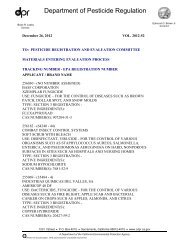Dichlorvos (DDVP) Risk Characterization Document - California ...
Dichlorvos (DDVP) Risk Characterization Document - California ...
Dichlorvos (DDVP) Risk Characterization Document - California ...
You also want an ePaper? Increase the reach of your titles
YUMPU automatically turns print PDFs into web optimized ePapers that Google loves.
may be involved in the alkylation of DNA. In vitro studies showed that dichloroacetaldehyde caused<br />
gene mutations in bacteria and dominant lethal mutations in mice (Aquilina et al., 1984).<br />
Therefore, in the absence of adequate data to evaluate the oncogenicity of <strong>DDVP</strong> by the inhalation<br />
route and in the presence of data from the gavage study (Chan, 1989) indicating potential<br />
oncogenicity, <strong>DDVP</strong> is assumed to be oncogenic by the inhalation route. The potency factor derived<br />
for mononuclear cell leukemia (a systemic effect) in rats (Chan, 1989) was used to assess human<br />
exposures.<br />
Oral<br />
Evidence of <strong>DDVP</strong> oncogenicity by the oral route was identified in rats and mice (Chan, 1989) (Tables<br />
4 and 7). In 2.9 and 5.7 mg/kg-day male rats, there were dose-related increases in the incidences of<br />
pancreatic adenoma and mononuclear leukemia. The results showed positive trends and were<br />
considered significantly (p @ 0.05) different from the concurrent controls based on Fisher's Exact test.<br />
In females, there were also dose-related increases in the incidences of pancreatic adenoma,<br />
mononuclear cell leukemia, and mammary gland tumors; even though the pair-wise comparison<br />
(except for mammary gland tumors found at 2.9 mg/kg-day) and trends were not statistically<br />
significant (at p @ 0.05). The NTP considered the increased incidences of pancreatic adenoma and<br />
mononuclear cell leukemia in male rats as some evidence of carcinogenicity 1 . In female rats, the<br />
increased incidences of mammary gland and pancreatic tumors were considered to be equivocal<br />
evidence of carcinogenicity.<br />
For pancreatic adenoma, there is evidence of progression to a malignant stage (McConnell et al.,<br />
1986). The NTP proposed that pancreatic adenoma and carcinomas should be combined for the<br />
evaluation of oncogenicity. These results were, however, confounded by the use of corn oil as the<br />
vehicle, as high incidences of pancreatic adenomas were found in the controls. Corn oil has been<br />
shown to induce pancreatic tumors in F344/N male rats (Eustis and Boorman, 1985; Haseman et al.,<br />
1985). In this study, <strong>DDVP</strong> may be a promoter rather than a direct carcinogen (Chan, 1989;<br />
Mennear, 1988). Consistent with the report by Haseman et al. (1985) for other compounds, corn oil<br />
did not have any effect in the females. Other studies have also shown an enhancement of toxicity and<br />
oncogenicity of organic compounds by corn oil (Condie et al., 1986, and Bull et al., 1986). However, a<br />
recent report by Huff and Hasemen (1991) showed that corn oil has little or no influence on the<br />
oncogenicity and that the previous finding may be due to a difference in body weight.<br />
The control incidences (11/50 and 17/50 for males and females, respectively) of mononuclear cell<br />
leukemias were within the range (1/50 to 22/50) of historical controls for NTP carcinogenesis studies<br />
conducted during that period (Stefanski et al., 1990). Comparison of concurrent control data with the<br />
historical control data confined to the testing period is appropriate because the background rate of<br />
certain tumor types, including leukemia, in F344 rats has been steadily increasing (Huff and<br />
Haseman, 1991). Possible reasons for the shift were: changes in histopathology diagnostic criteria<br />
over time, changes in the amount of tissue examined, intra- and interlaboratory variability, and dietary<br />
factors.<br />
1/ The descriptions of the evidence classification from the NTP are:<br />
Clear evidence - there is a dose-related increase of malignant neoplasms, a combination of<br />
malignant and benign neoplasms, or marked increase of benign neoplasm if there is an<br />
indication that such tumors have the ability to progress to malignancy.<br />
Some evidence - there is a chemically-related increase in the incidence of neoplasms<br />
(malignant, benign, or combined) but have less strength than clear evidence.<br />
Equivocal evidence - there is a marginal increase of neoplasms that may be chemically<br />
related.<br />
59
















